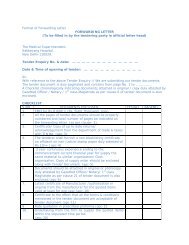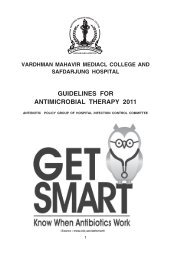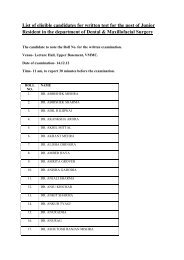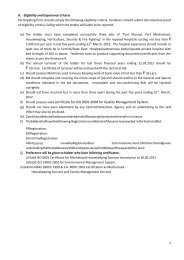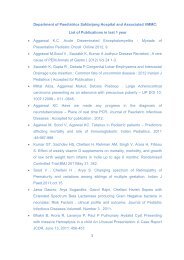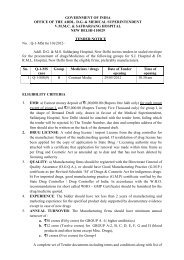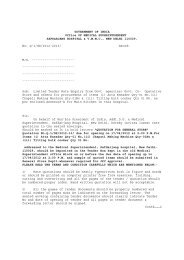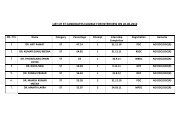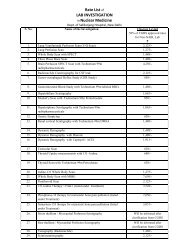Guidelines for INFECTION CONTROL POLICY - Safdarjung Hospital
Guidelines for INFECTION CONTROL POLICY - Safdarjung Hospital
Guidelines for INFECTION CONTROL POLICY - Safdarjung Hospital
You also want an ePaper? Increase the reach of your titles
YUMPU automatically turns print PDFs into web optimized ePapers that Google loves.
peripherals, telephones, answering machines, radios, stereo equipment, tape players/recorders,phonographs, video cassette players/recorders, compact disc players/recorders, calculators, andsome appliances. Certain components of some electronic products contain materials that renderthem hazardous, depending on their condition and density. Nonfunctioning CRTs (cathode raytubes) from television and monitors are considered as hazardous. There<strong>for</strong>e, nonfunctioningCRTs from television and monitors are banned from the trash. All electronic waste will be‘contained’ in the area of use. E-waste recyclers authorized by Central Pollution Control Boardwill be contacted <strong>for</strong> collection and final disposal of E-waste.As per guidelines issued by DGHs, a clause <strong>for</strong> Buy back policy may be included at the timeof tendering <strong>for</strong> purchase of electronic Equipment <strong>for</strong> minimization of E-waste.EFFLUENT TREATMENT PLANT :The design and operation of wastewater treatment system <strong>for</strong> hospital is a. These liquideffluents, directly rejected in the network drainage of laboratories, and other clinical areas ofthe hospital, can contribute under certain physico-chemical conditions to the presence of thevirus in the urban sewer network and in the wastewater treatment plant. <strong>Hospital</strong> wastewaterreveals the presence of molecules chlorinated in high concentrations and in a punctual way thepresence of heavy metals such as mercury and sliver. DPCC has issued notice that 500 ormore bedded hospitals should install the ETP in their hospitals. ETP of Safdarjang <strong>Hospital</strong> isunder process and is likely to be functional shortly.6. SAFETY ISSUES AND OTHER PROTOCOLSPPE & VACCINATION OF THE HEALTH CARE WORKERS:All waste handlers have been provided with Masks, Caps, Gum Boots, Gloves, and Disposableapron which they are expected to wear while dealing with the waste. All health care workers arevaccinated against Hepatitis B and tetanus.DEALING WITH SPILLAGE :Liquid spill management :For small volume spills:• Cover spills of infected or potentially infected material on the floor with paper towel/blotting paper/news paper. Pour 5% Phenol or freshly prepared 5% hypochloritesolution.• Leave <strong>for</strong> 30 minutes <strong>for</strong> contact• Then it wipe with gauze or cloth with gloved hands.• The gauze or cloth used to wipe is to be considered as noninfectious waste anddiscarded in general waste.For large volume spills:• Wear gloves.• Mop with absorbent cotton/gauze and discard it to infectious waste bin• Cover spills of infected or potentially infected material on the floor with paper towel/blotting paper/news paper. Pour 5% Phenol or freshly prepared 5% hypochloritesolution.• Allow it <strong>for</strong> 30 min contact period.• Wipe thoroughly with gloved hands using cotton or gauze and treat the gauze as sooninfectious waste and dispose accordingly.NB : Any material treated wit hypo-chlorite solution should never be sent <strong>for</strong> incineration28



